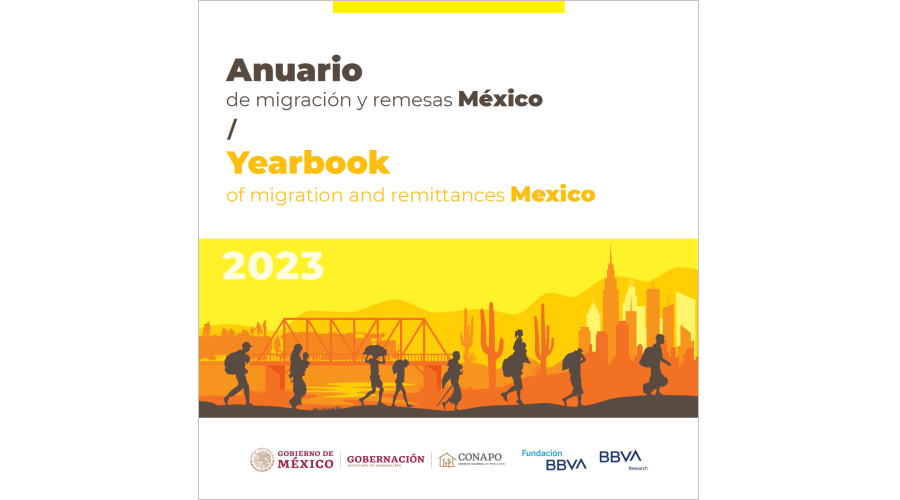Published on Thursday, August 24, 2023 | Updated on Tuesday, March 19, 2024
Mexico | Yearbook of Migration and Remittances 2023
Summary
Book edited by BBVA Research, BBVA Foundation and the National Population Council (CONAPO) made up of 10 chapters that addresses the main statistics on the multiple migratory flows and human mobility, and remittances at a global level, with an emphasis on Mexico.
Key points
- Key points:
- The average salary gap between Mexico and the United States continues to be very wide: 14 times at the junior high-school level (261 vs. 3,672 current dollars per month) and 8.5 times for undergraduate studies (562 vs. 4,792 current dollars per month).
- Between January 2021 and June 2023, undocumented Mexican migration to the US remained at high levels. This period averages 63,000 monthly migratory encounters, although in recent months the flow has decreased.
- Documented Mexican labor migration has grown to record levels. Between 2019 and 2022, H-2A visas (Temporary Agricultural Work) for the Mexican population grew 46.3%, up to 276 thousand.
- The saturation of asylum applications in the US leads thousands of migrants to remain on the northern border of Mexico. As of the end of 2022, the US had more than 1.3 million pending applications and cases. The US asylum system can only resolve 41,000 applications and 53,000 cases per year.
- Mexico consolidates its position as the 2nd country with the most remittances in the world; it will surpass China by more than $10,000 md. It is estimated that remittances to Mexico will close at $63,700 md (+8.9%) by 2023 and will reach $67,900 md (+6.6%) in 2024.

The 2023 edition of the Yearbook of Migration and Remittances Mexico was prepared in the run-up to the World Health Organization (WHO) declaration of the end of the international health emergency due to the COVID-19 pandemic, in force since March 2020. In this issue, the complexity of international migration, as a broad social fact, is intertwined with other forms of human mobility, such as the need for refuge and asylum. Each volume of the Yearbook includes chapters that, to use an analogy, are the backbone of the Yearbook, in addition to another set of chapters that account for changes in the current situation. This issue is made up of ten chapters.
World migration seen through the subregions of origin and destination with their main corridors, as well as the examination of its composition by sex and its demographic structure make up the first chapter. The second analyzes the trends in the volume of refugees under UNHCR protection, their main international corridors and countries of origin, as well as recent changes in the volume and origin of the refugee population in Mexico and of the Mexican refugee population in other countries. Information on the international student population is addressed in the third chapter, which presents changes in the flow of the internationally mobile students, and delves into statistics in the United States and Mexico regarding this issue.
Chapter four presents the changes in the size of the first-, second- and third-generation Mexican populations living in the United States. In addition, first-generation households are analyzed through variables such as the origin of the spouse and the number of members. Chapter five recognizes the importance of the United States as a destination for contemporary migration, although mostly unauthorized, but also authorized migration is addressed. In both cases, the aim is to address the most relevant aspects of that country’s immigration policy from a statistical point of view.
Chapter six reports on the situation of international migration in Mexico by means of the Mexico-United States Migratory Intensity Degree at a federal entity level. With a similar intention, it gives an account of the migratory circuits between both countries, highlighting for each federal entity the main municipalities of origin in Mexico and the main destination states in the United States. Chapter seven provides an account of the number of migrant children, their origin and composition by gender, as well as the latest changes in the migration of this population group. Chapter eight provides a comprehensive approach to the different human movements present in Mexico, including the Mexican population returned by the immigration authorities of the United States and Canada.
Finally, the long tradition of international migration in Mexico shows that the sending and receiving of remittances is an inherent aspect of it. In addition to being foreign currency for the economy, they are a sign of the commitment and solidarity that migrants have for their families, expressing social relations between the migrant and his or her family and community of origin. The ninth and tenth chapters gather international and national statistics on remittances, highlighting the upward trend of remittances in the main receiving countries such as Mexico, pointing out indicators of economic dependence and the cost of sending them.
Thus, the eleventh edition of the Yearbook of Migration and Remittances Mexico shows with objectivity and technical rigor the changes and continuities in the subject, and its impact on the welfare of the migrant population and societies. We believe that the information provided can be consulted and used for the progress and evaluation of the actions, strategies and programs carried out by different actors, and as a complement to the contributions made by the academic sector for a better understanding of international migration, human mobility and remittances.
Geographies
- Geography Tags
- Global
- Latin America
- Mexico
Topics
- Topic Tags
- Migration
Documents and files
Authors
Was this information useful?
